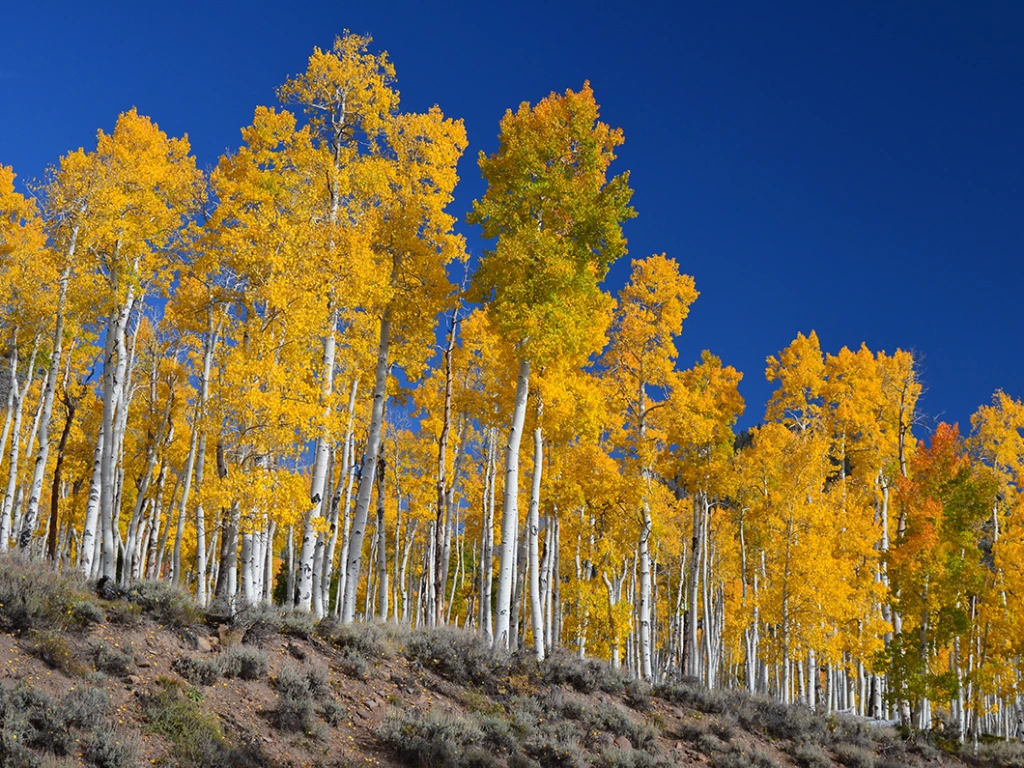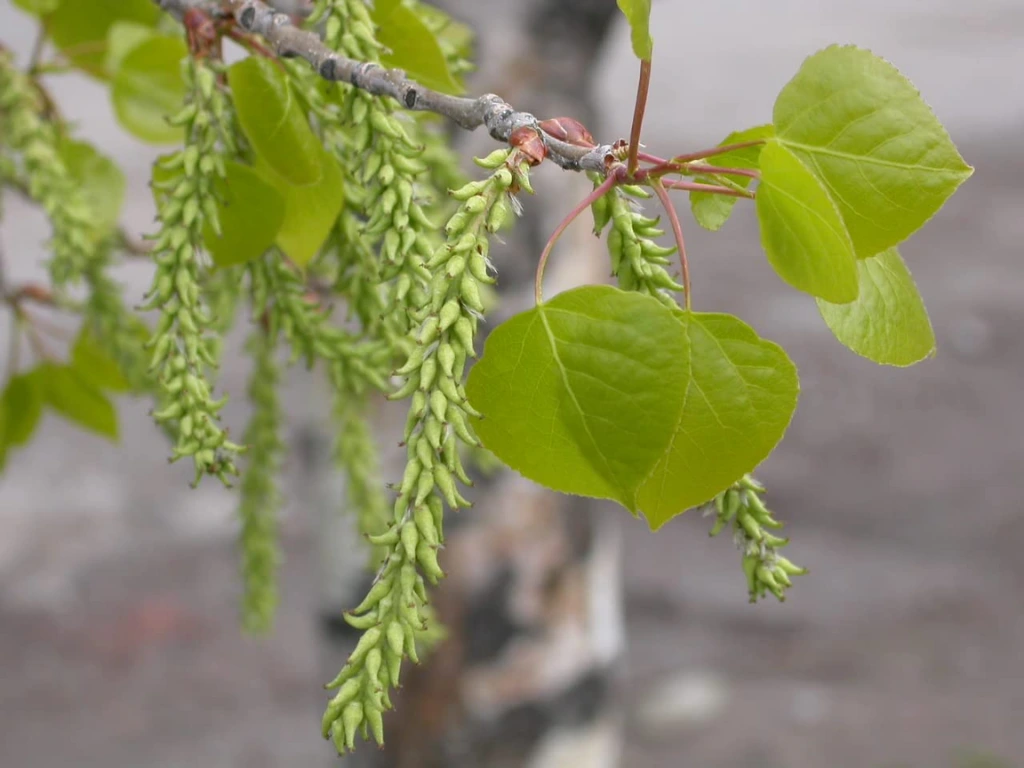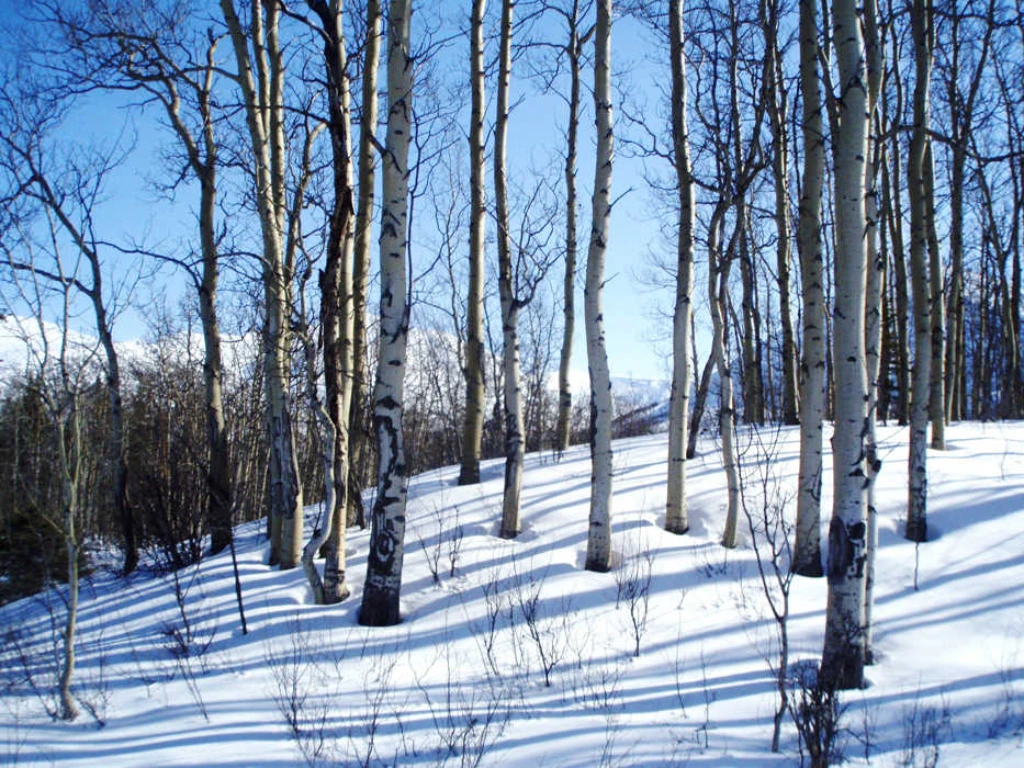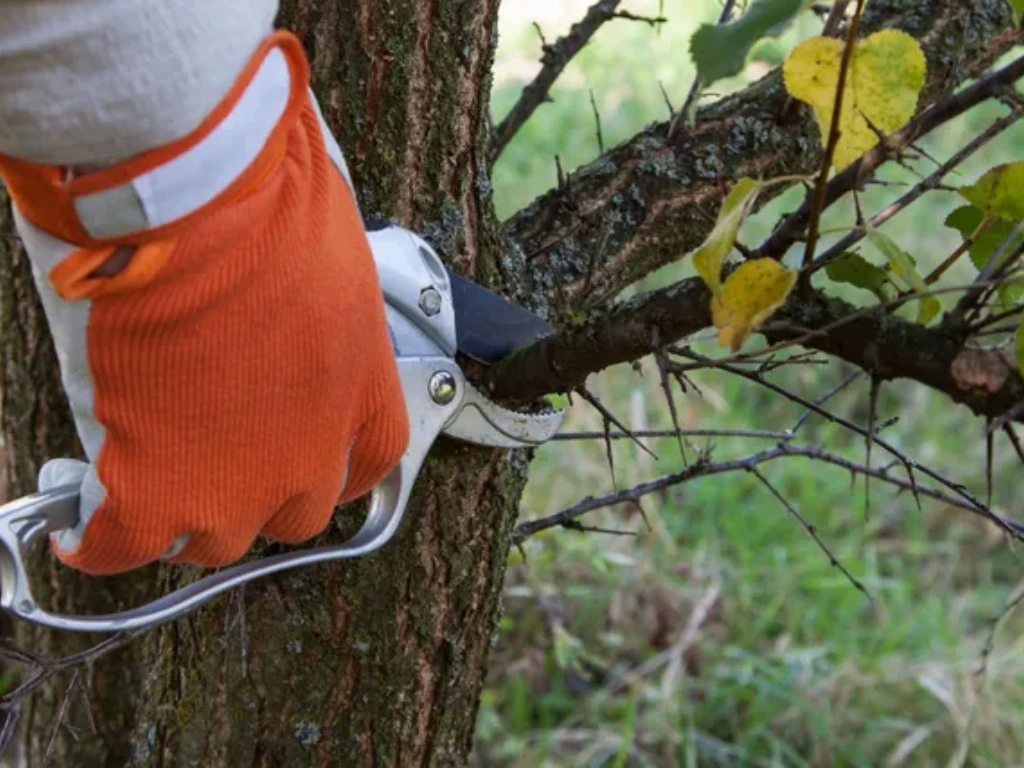There’s something undeniably magical about a Quaking Aspen. With their shimmering golden leaves, graceful white bark, and signature leaf flutter that gives them their name, these native North American trees light up wild landscapes every fall. But can that same beauty thrive in your backyard? While stunning and fast-growing, Quaking Aspens come with its quirks—like spreading roots and short lifespans—that every gardener should understand before planting. In this guide, we’ll explore everything you need to know about how to grow Quaking Aspen trees successfully—from choosing the right sapling to managing root suckers—so you can enjoy their movement, light, and life in your garden.
What are Quaking Aspen Trees?

The Quaking Aspen (Populus tremuloides) is a deciduous tree native to North America. It gets its name from the way Quaking Aspen leaves flutter or “quake” in the slightest breeze due to their flattened petioles. This gentle rustling sound is calming, almost musical, and adds a unique charm to your landscape.
Key Features
-
Fast growth: One of the fastest-growing deciduous trees, perfect for impatient gardeners!
-
Cold-hardy: Thrives in USDA zones 1–7, making it ideal for northern states
-
Natural beauty: Iconic white bark and shimmering foliage create year-round visual interest
-
Eco-friendly: Supports wildlife like deer, birds, and butterflies; great for native landscaping
If you’re looking for a tree that adds instant character to your yard and grows into a stunning grove over time, the Quaking Aspen is a top contender.
Benefits of Growing Quaking Aspen

Quaking aspen is more than just a pretty tree — it offers a host of practical, environmental, and aesthetic benefits that can make a big difference in your landscape.
First off, they’re excellent at carbon sequestration, meaning they help absorb carbon dioxide from the atmosphere and release clean oxygen back into the air. It’s a small way to contribute to a healthier planet, one tree at a time.
They’re also incredibly helpful for erosion control, especially on sloped properties or near water features. Their dense root systems help stabilize soil and prevent runoff, making them ideal for areas prone to erosion.
From an ecological perspective, Quaking Aspens provide significant wildlife value. Their Quaking Aspen leaves, bark, and shoots offer food for deer, elk, and rabbits, while their canopy creates shelter and nesting opportunities for birds, butterflies, and beneficial insects.
And of course, they’re a visual showstopper. With their shimmering leaves, bright white bark, and stunning golden fall color, Quaking Aspens add year-round beauty to any landscape. Whether planted as a standalone feature or in a grove, they bring movement, sound, and seasonal interest to your yard.
So yes — they’re not just beautiful; they’re wonderfully practical too. Choosing to grow a Quaking Aspen is a decision that pays off in beauty, utility, and environmental benefit for years to come.
Ideal Growing Conditions
Getting the basics right is half the job when growing Quaking Aspens. These trees are tough but will thrive with the right start.
Best USDA Zones for Quaking Aspen
These trees prefer cooler climates. They’re commonly found in the Rockies, Great Lakes, and northern U.S. but can grow in zones 1 through 7.
Soil Type and Drainage
Aspens prefer well-draining soil that’s slightly acidic. Sandy loam is perfect, but they can adapt as long as drainage is good. If your soil is heavy clay, consider raised beds or soil amendments.
Garden Tip: Mix compost and peat moss into the soil to improve drainage and acidity.
Sunlight and Watering Needs
-
Sunlight: Full sun (6+ hours/day) is ideal for strong growth and vibrant foliage
-
Watering: Water young trees weekly; mature trees are moderately drought-tolerant but benefit from deep watering in dry periods
Pro Tip: Mulch around the base (but not touching the trunk) to retain moisture and protect the roots from temperature extremes.
When to Transplant Quaking Aspen
Maybe you started with a container-grown Aspen and now want to move it into the ground, or you’re transplanting a sucker from an existing tree. Either way, timing and technique are key to ensuring your tree handles the transition smoothly.
The best time to transplant a Quaking Aspen is during its dormant periods — either in early spring before bud break or late fall after leaf drop. This reduces stress on the tree and helps it focus on root establishment instead of top growth.
Read more: Spring 2025: The Golden Time to Plant Trees
How to Plant Quaking Aspen

Planting a tree can feel like a big step, but I promise it’s easier than it sounds. Here’s how you can confidently plant a Quaking Aspen.
Choosing the Right Sapling or Cutting
Here’s what to look for:
-
Healthy green leaves: No brown spots, yellowing, or signs of wilting
-
Strong, upright stems: Avoid saplings that are leaning or look spindly
-
No signs of pests or disease: Check the undersides of Quaking Aspen leaves and the base of the trunk for insects, mold, or rot
Don’t hesitate to ask the nursery staff about the tree’s age, whether it’s been hardened off (prepared for outdoor planting), and the growing conditions it was raised in. A little Q&A upfront can save a lot of headache later.
Alternatively, if you already have a mature Quaking Aspen nearby or know someone who does, you can propagate using a root sucker. These are the young shoots that pop up from the root system of an existing tree. They transplant well when dug with care and provide an affordable way to start a grove.
Read more: How to Grow Quaking Aspen Trees from Root Cuttings
Step-by-Step Planting Instructions
Now that you’ve got your tree, it’s time to get it into the ground. Follow these steps to give it the best start:
-
Dig a hole that’s twice as wide and just as deep as the root ball. This gives roots room to spread and prevents them from circling.
-
Place the tree upright in the center of the hole. Make sure the root collar (where the roots meet the trunk) is level with the ground surface.
-
Backfill using the original soil. Avoid using rich potting soil or fertilizer at this stage — it can shock young roots.
-
Press down gently around the base to eliminate air pockets and help the tree settle.
-
Water deeply to soak the entire root zone. You want to encourage the roots to grow downward.
-
Add mulch around the base, about 2–3 inches thick, to retain moisture and suppress weeds. Just make sure the mulch doesn’t touch the trunk itself, as that can cause rot.
Planting might sound technical, but think of it like tucking your tree into a cozy bed with plenty of room to grow.
Spacing Quaking Aspen Trees
Here’s where a little planning goes a long way. Quaking Aspens are known for spreading through underground root suckers, which can quickly turn one tree into a whole cluster if you’re not careful.
To keep things under control:
-
Plant at least 20 feet apart if you want them to grow as individual trees
-
Space 10 to 15 feet apart if your goal is to create a natural grove that spreads organically over time
Also consider what’s nearby. Avoid planting them too close to driveways, sidewalks, or garden beds where suckers might become an issue. Root barriers can help manage the spread if space is limited.
Friendly reminder: These trees love to grow together, so if you want that storybook forest feel, go with tighter spacing. If you want structure and separation, give them room to breathe.
Quaking Aspen Tree Care
Once your Aspen is in the ground, ongoing care ensures it stays healthy and looks great for years to come. The good news? Quaking Aspens are relatively low-maintenance, but there are a few key things to stay on top of to make sure your tree thrives long-term.
Watering Schedule by Season
Proper watering can make or break your Aspen’s success, especially in the first few years.
-
Spring/Summer: Water weekly during dry spells. Young Aspens (up to 2–3 years old) need consistent moisture to establish their root systems. Deep, slow watering is best — think long soaks, not frequent splashes.
-
Fall: Gradually reduce watering as the temperatures cool, but don’t let the soil completely dry out. This is a crucial time for roots to store up energy for winter.
-
Winter: Only water during prolonged dry periods, particularly if there’s no snow. Frozen ground doesn’t require irrigation, but dry winter winds can dehydrate roots in exposed areas.

Garden Tip: Stick your finger a couple inches into the soil. If it feels dry at that depth, it’s time to water.
Fertilization Tips
Quaking aspen doesn’t need a lot of fertilizer, especially in rich soil. Overfeeding can lead to weak growth and pest problems.
-
Apply a balanced, slow-release fertilizer (like 10-10-10) in early spring, starting the second year after planting.
-
Avoid high-nitrogen fertilizers, which can encourage rapid leaf growth but weaken the tree’s structure.
-
Sprinkle fertilizer evenly around the drip line (where the tree’s canopy ends), and water thoroughly afterward.
Organic option: Compost or well-aged manure can be used as a natural alternative to commercial fertilizers.
Managing Root Suckers
Here’s one of the quirks of Quaking aspen — they love to spread! Root suckers are a survival strategy in nature, but in a home landscape, they can take over if not managed.
How to handle suckers effectively:
-
Mow or snip them regularly. The more often you cut them, the fewer will return over time.
-
Install underground barriers to restrict how far the roots can spread, especially near sidewalks or fences.
-
Use mulch or groundcover plants to smother new shoots. Dense groundcover can block sunlight and discourage sucker growth.
-
Stay consistent: If you skip maintenance for even a few weeks in spring, you might find a mini forest popping up where you least expected.
Fun Fact: A single Aspen grove in Utah is actually one of the world’s largest living organisms, all connected by one root system! It covers over 100 acres and weighs more than 6,000 tons.
Managing suckers may sound like a chore, but if you stay ahead of them, it’s easy. Some gardeners even embrace them to grow a natural-looking grove right in their backyard. It all comes down to how wild or tidy you want your landscape to be.
Common Problems and Solutions

No plant is perfect, and Quaking Aspens have its fair share of quirks and challenges. Knowing what to expect — and how to respond — can keep small problems from turning into big ones.
One of the most common issues is leaf spot, specifically caused by the Marssonina fungus. It shows up as small brown or black spots on the Quaking Aspen leaves, and while it won’t kill the tree, it can make it look unsightly. The best way to manage it is to rake and dispose of fallen leaves in autumn and avoid overhead watering, which spreads fungal spores.
Another issue to watch for is Cytospora canker, a fungal disease that causes sunken, discolored patches on the bark. If you notice this, prune out affected branches and improve airflow around the tree by trimming nearby vegetation. Always sanitize your tools after pruning to avoid spreading the infection.
Aphids can also be a nuisance. These tiny, sap-sucking pests tend to cluster on the undersides of Quaking Aspen leaves, causing curling or yellowing. You can spray them off with water, use insecticidal soap, or introduce beneficial insects like ladybugs to keep their numbers down naturally.
As for tree size, Quaking Aspens can reach heights of 40–50 feet if left unpruned. To manage size and shape, conduct light pruning in late winter, when the tree is dormant. Remove any dead, damaged, or weak branches to keep the tree healthy and structurally sound. One important rule: never top a Quaking Aspen. Topping not only ruins the natural form but also invites disease and creates weak, unstable growth.
FAQs About Growing Quaking Aspen
1. How fast do Quaking Aspen trees grow?
Under ideal conditions, Quaking Aspens grow around 1.5 to 2 feet per year, making them one of the fastest-growing deciduous trees. Their rapid growth is perfect for homeowners looking to establish shade or privacy quickly.
2. Can I grow a Quaking Aspen in a pot?
You can grow one in a container temporarily, especially when young. However, their aggressive root system quickly outgrows pots, making long-term container growing impractical and unhealthy for the tree.
3. How do I prevent the roots from spreading too far?
To manage spreading, install root barriers and remove suckers regularly. Also, planting the tree in a naturally contained area or near hardscape features can help limit its underground expansion.
4. Are Quaking Aspens good for privacy?
Absolutely! Their dense foliage in summer, quick growth, and tendency to form groves make them excellent for creating natural living screens that provide both shade and privacy.
Final Tips
If you want a tree that grows fast, looks stunning year-round, and adds real value to your landscape, the Quaking Aspen is a smart pick.
To recap:
-
Choose the right location and well-draining soil
-
Keep up with watering, especially in the first couple of years
-
Mulch and fertilize wisely
-
Prune gently and manage root spread if needed
-
Enjoy their beauty and the wildlife they attract
Start small and let nature do the rest — one tree can turn into a thriving grove before you know it.
Looking to explore more tree options? Check out our guides on Care Tips.
Happy planting!
